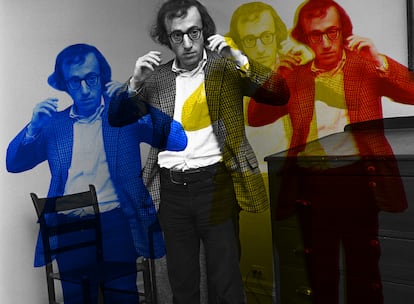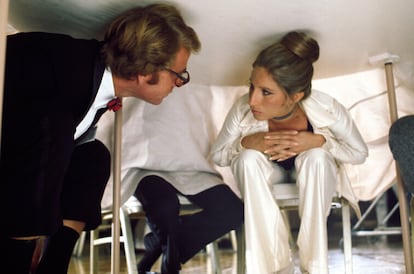The risky illusion of idealizing shyness: It creates problems at work and monsters online
In the era of personal marketing, a withdrawn personality has the potential to become problematic

In a recent interview, Spanish writer Eloy Tizón, famous for writing stories full of characters who doubt, hold back and prefer to escape rather than expose themselves, stated that shyness could be a generational phenomenon. He may be onto something: during the 1990s and the early 2000s, shyness sold books, filled movie theaters and gave rise to an entire rock subgenre: shoegaze (where constantly looking at the guitar’s pedals served the double purpose of avoiding the eyes of the crowd). Today, however, Amélie (2001) is not as charming as it was 20 years ago, we cannot fully empathize with Adam Sandler in Punch-Drunk Love (2002) and Joaquin Phoenix comes off as creepy in Her (2013).
The culture of therapy (or self-care) and that of activism (which is projected towards others) have enjoyed prestige and the attention of the market for years. They are so widespread and popular that they inspire both forms of resistance and marketing strategies — and shyness is a most counterproductive attribute for these two universes. If, as philosopher Sara Ahmed has been defending since 2004, emotions are also politics, what sense would it make to repress them instead of expressing them, other than to maintain unfair situations or privileges? So whether it is to change things, to get a promotion, to externalize your innermost traumas or to sell a podcast: to be yourself, you can no longer be shy.
Bad times for the Woody Allens of the world
“The contemporary world demands qualities opposite to shyness. However, instead of putting an end to it, maybe this just hides it more. What’s in full decline is the figure of the ostentatious shy person, the glamorization of shyness,” says Spanish musician Marcelo Criminal. “I’m thinking about the brutal decline of the quintessential shy man: Woody Allen. Beyond the other issues for which he is disliked, his character has no prestige in today’s world.”

Philosopher Elena Castro agrees: shy people have not become extinct, they just changed due to the intervention of the screens. She elaborates: “In order to take a selfie, you must look directly at the camera. This holding of the gaze is associated with expressiveness. But, in reality, the person that looks at their shoes while they sing, as a gesture of openness to others, is not so different from the shy one who takes a selfie. Maybe now the tension between expressiveness and shyness means that you are capable of doing a live stream, but still have a hard time interacting in real life.”
Shyness at the office
Even though shy characters are no longer attractive, shyness is clearly still among us. But what is the essence of it? To what extent is it more incapacitating today than ever? Raquel Hevia, psychologist and human resources specialist, responds: “Shyness is one thing and introversion is another. Shyness is the fear of being observed or judged by others, which leads to avoiding social situations. It is an avoidance strategy. Introversion is a personality trait that has to do with calmness, reflection or spending time alone.”
However, even though these might seem like bad times for the timid (the border between the public and the private is more permeable than ever, not to mention that many work environments demand constant publicness), “since the internet is in itself a mask,” Hevia reflects, “now there are more contexts where you can have a functional life without being completely exposed.” Furthermore, all is not lost outside the virtual world. Face to face, an introvert “can be a good leader, even more empathetic, because they spend more time listening to others than talking… and most of the things that affect communication take place before we open our mouths.”
His teachers said it: Serge Gainsbourg was a shy child who knew how to change (perhaps too much). In any case, does a shy person really need to modify their behavior? “If we talk about pathological shyness,” continues the psychologist, “we have to work on it like we work on phobias. The person must know its origin and re-perceive their environment as a safe environment.”

In less serious cases, overcoming shyness usually helps in work situations that require fluid communication with colleagues that are as busy as you. It is not about matters like competence or the “personal brand;” it is about avoiding the frustration of others not recognizing true talent and effort. People with imposter syndrome and high levels of shyness face this on a regular basis. Hevia explains: “Sometimes we feel that what we do speaks for us. But when you only focus on doing things well, it is very difficult for others to notice, because everyone is focused on their own tasks. Being able to show what you are and what you do is as important as being it and doing it. When you have a real, concrete skill, it’s important that you devote some energy to making it visible. Shyness and introversion are a barrier: if you don’t raise your hand, no one will know that you know the answer.”
Shyness and gender: From the Victorian woman to the incel
When it comes to phenomena related to communication — and shyness is one of them — analyzing how much and when the sender opens their mouth is as necessary as knowing where they do it from and who takes advantage of their silence. “If we think about shyness in capital letters,” says Castro, “which we relate to modesty, we realize that it is closely linked to the female subject who represses her desire and whose value is measured by the reachability of her closeness, openness or privacy. The woman has to be shy so that this whole heterosexual narrative of achieving affection in terms of a gain can go forward.” This is a model, the philosopher adds, that fortunately “is now seen almost as a parody.” She gives an example: “those dreadful verses [by Pablo Neruda], ‘I like you when you are quiet because it is as though you are absent,’ which we can no longer hear because what used to be taken as an eroticization of shyness or mystery is actually sexism, enjoying the silence of the person next to him so he can talk non-stop.”
However, with the remains of a model that is finally beginning to collapse, some men have formed in certain corners of the internet misogyny circles or incel communities: the darker side of contemporary shyness. It is no coincidence that the space that has hosted the messages of this community for the longest number of years was called Love-shy.com. Incels (or “involuntary celibates”) believe in a sex/gender system that works as a market that they cannot access. These adults or teenagers have minimum contact with the women that surround them and believe that conquest is the only way a man and a woman can possibly relate. As per their own stories, if they are incapable of achieving these conquests it is due to their shyness.
In fiction, a man in danger of becoming an incel is usually saved at the last moment by a Manic Pixie Dream Girl, an archetype of “those very young, white girls, which alternate states of repression with bursts of eccentricity,” in Castro’s words. Ramona Flowers, from Scott Pilgrim vs. the World (2010), is one of the most famous MPDGs, as well as one of the biggest obsessions of the incels, who have turned her into the subject of hundreds of memes and a symbol of everything they hate and, at the same time, desire. Other notable examples are Barbra Streisand in What’s Up, Doc? (1972) and Zooey Deschanel in 500 Days of Summer (2009).
In any case, what drives the incel community — which is closely related to other sectors of the extreme right — to spread hate messages and, in the worst cases, to commit acts of terrorism, is not shyness: it is sexism.
Old shyness, new honesty?
A few months ago, actors Paul Mescal (who appears in the 2020 adaptation of Sally Rooney’s novel Normal People and in last year’s film Aftersun) and Joe Alwyn (who in 2022 was in Conversations with Friends, by the same author) said that they have a WhatsApp group chat called Tortured Man Club. Statements like this — which border on clichés — in the context of the so-called Sally Rooney phenomenon, around a writer obsessed with the honesty of her characters, can be taken as a nod to the “new sincerity,” the expression that literary criticism used to refer to what separated David Foster Wallace’s novels from the previously dominant American narrative. The novelty was that — sometimes in an exaggerated way — Wallace’s characters renounced cynicism and sought to express themselves and act just as (they believed) they were, that is, they wanted to be “authentic” (and, along the way, overcome their shyness).
Since then, the label “new sincerity” has been applied to almost all artistic disciplines, to the point of becoming an aesthetic that, according to Castro, would be related to “such a great excess of expressiveness or emotionality that the viewer suspects that what they are seeing is ironic.” The new sincerity, the philosopher continues, “is not an overcoming of shyness, but a suspicion of whether what the other person is doing or saying is genuine or not. Once the theme of pastiches, irony or post-irony is behind, an apparently unfiltered and naive expressiveness raises suspicion that there is a double ironic twist.
Castro also believes that many neo-sincere people resort to childish aesthetics because childhood is the stage of life during which shyness is more normalized. “Claiming aesthetics of the small, the cute and the infantile, queer and dissident subjects pose impossibilities to a normative social functioning. Someone dressed as a modest fairy poses a form of resistance to communication and consumption codes,” she concludes.
As for Marcelo Criminal, his work is full of characters who openly address their shyness and who, by talking about it, make it somehow disappear or transform. “These characters are frequent in my work because I am greatly influenced by the online world in which shy people usually find solace. I have been on social media all my life, and the people there are often not well. Online cries for help are the literary genre that I have read the most in my entire life.” Online cries for help are one of the most important social phenomena in recent years — for the shy ones, too, who no longer seem absent.
Sign up for our weekly newsletter to get more English-language news coverage from EL PAÍS USA Edition
Tu suscripción se está usando en otro dispositivo
¿Quieres añadir otro usuario a tu suscripción?
Si continúas leyendo en este dispositivo, no se podrá leer en el otro.
FlechaTu suscripción se está usando en otro dispositivo y solo puedes acceder a EL PAÍS desde un dispositivo a la vez.
Si quieres compartir tu cuenta, cambia tu suscripción a la modalidad Premium, así podrás añadir otro usuario. Cada uno accederá con su propia cuenta de email, lo que os permitirá personalizar vuestra experiencia en EL PAÍS.
¿Tienes una suscripción de empresa? Accede aquí para contratar más cuentas.
En el caso de no saber quién está usando tu cuenta, te recomendamos cambiar tu contraseña aquí.
Si decides continuar compartiendo tu cuenta, este mensaje se mostrará en tu dispositivo y en el de la otra persona que está usando tu cuenta de forma indefinida, afectando a tu experiencia de lectura. Puedes consultar aquí los términos y condiciones de la suscripción digital.
More information
Últimas noticias
Daytime, headphones, no booze involved: How a generation is saying ‘no’ to club parties
Millennia-old Yuracaré language resists extinction through 900 speakers and a new dictionary
Susan Boyle prepares a comeback just as Timothée Chalamet sings her praises
Trump suspends green card visa lottery after shooting at Brown University
Most viewed
- Christian Louboutin: ‘Young people don’t want to be like their parents. And if their parents wear sneakers, they’re going to look for something else’
- Cartels in Mexico take a leap forward with narco-drones: ‘It is criminal groups that are leading the innovation race’
- Liset Menéndez de la Prida, neuroscientist: ‘It’s not normal to constantly seek pleasure; it’s important to be bored, to be calm’
- ‘El Limones’ and the growing union disguise of Mexican organized crime
- US sanctions against jailed cartel leader ‘El Marro’ highlight Mexico’s lack of control over its prisons










































